Woodlouse
A woodlouse (plural woodlice) is a crustacean from the monophyletic[2] suborder Oniscidea within the isopods. They are called that from being found in old wood.[3]
| Woodlice | |
|---|---|
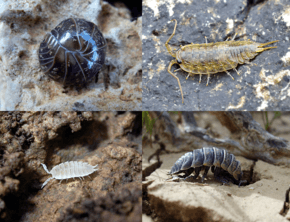 | |
| Clockwise from top right: Ligia oceanica, Hemilepistus reaumuri, Platyarthrus hoffmannseggii and Schizidium tiberianum | |
| Scientific classification | |
| Kingdom: | Animalia |
| Phylum: | Arthropoda |
| Subphylum: | Crustacea |
| Class: | Malacostraca |
| Superorder: | Peracarida |
| Order: | Isopoda |
| Suborder: | Oniscidea Latreille 1802[1] |
| Sections | |
| |
The first woodlice were marine isopods which are presumed to have colonised land in the Carboniferous.[4] They have many common names and although often referred to as 'terrestrial Isopods' some species live semiterrestrially or have recolonised aquatic environments. Woodlice in the families Armadillidae, Armadillidiidae, Eubelidae, Tylidae and some other genera can roll up into a roughly spherical shape as a defensive mechanism; others have partial rolling ability but most cannot conglobate at all.
Woodlice have a basic morphology of a segmented, dorso-ventrally flattened body with seven pairs of jointed legs, specialised appendages for respiration and like other peracarids, females carry fertilised eggs in their marsupium, through which they provide developing embryos with water, oxygen and nutrients. The immature young hatch as mancae and receive further maternal care in some species. Juveniles then go through a series of moults before reaching maturity.
While the broader phylogeny of the Oniscideans has not been settled, five Infraorders/Sections are agreed on with 3,637 species validated in scientific literature in 2004[5] and 3,710 species in 2014 out of an estimated total of 5,000–7,000 species extant worldwide.[6] Key adaptations to terrestrial life have led to a highly diverse set of animals; from the marine littoral zone and subterranean lakes to arid deserts and mountain slopes 4,725 m (15,500 ft) above sea-level, woodlice have established themselves in most terrestrial biomes and represent the full range of transitional forms and behaviours for living on land.
Woodlice are widely studied in the contexts of evolutionary biology, behavioural ecology and nutrient cycling. They are popular as terrarium pets because of their varied colour and texture forms, conglobating ability and ease of care.
Common names
Common names for woodlice vary throughout the English-speaking world. A number of common names make reference to the fact that some species of woodlice can roll up into a ball. Other names compare the woodlouse to a pig.
Common names include:
- "armadillo bug"[7]
- "boat-builder" (Newfoundland, Canada)[8]
- "butcher boy" or "butchy boy" (Australia,[9] mostly around Melbourne[10])
- "billy baker" (South Somerset)
- "carpenter" or "cafner" (Newfoundland and Labrador, Canada)[11]
- "cheeselog" (Reading, England)[12]
- "cheesy bobs" (Guildford, England)[13]
- "cheesy bug" (North West Kent, England)[14]
- "chiggy pig" (Devon, England)[15][16]
- "chucky pig" (Devon, Gloucestershire, Herefordshire, England)[17]
- "chuggy peg" (North Devon)
- "daddy grampher" (North Somerset)
- "doodlebug" (also used for the larva of an antlion)[18]
- "gramersow" (Cornwall, England)[19]
- "granny grey" (South Wales)[20]
- "hog-louse"[21]
- "menace" (Plymouth, Devon)
- "monkey-peas" (Kent, England)[14]
- "monk's louse" (transl. "munkelus", Norway)[22]
- "pea bug" or "peasie-bug" (Kent, England)[14]
- "pill bug" (usually applied only to the genus Armadillidium)[23]
- "potato bug"[24]
- "Crawley Baker" Dorset
- "roll up bug"[25]
- "roly-poly"[24]
- "sow bug"[26]
- "slater" (Scotland, Northern Ireland, New Zealand and Australia)[27][28][29]
- "wood bug" (British Columbia, Canada)[30]
- ”Piggy Wig”
- “Earwig”
- ”Granny Grey”
- "wood-louse"
- "cheesey wig"
Description and life cycle
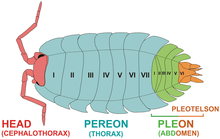
The woodlouse has a shell-like exoskeleton, which it must progressively shed as it grows. The moult takes place in two stages; the back half is lost first, followed two or three days later by the front. This method of moulting is different from that of most arthropods, which shed their cuticle in a single process.
A female woodlouse will keep fertilised eggs in a marsupium on the underside of her body until they hatch into offspring that look like small white woodlice curled up in balls. The mother then appears to "give birth" to her offspring. Females are also capable of reproducing asexually. [31]
Despite being crustaceans like lobsters or crabs, woodlice are said to have an unpleasant taste similar to "strong urine".[31]
Pillbugs and pill millipedes
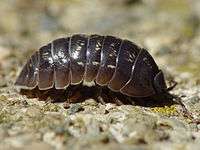
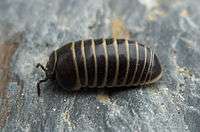
Pillbugs (woodlice of the family Armadillidiidae, also known as pill woodlice) can be confused with pill millipedes of the order Glomerida.[32] Both of these groups of terrestrial segmented arthropods are about the same size. They live in very similar habitats, and they can both roll up into a ball. Pill millipedes and pillbugs appear superficially similar to the naked eye. This is an example of convergent evolution.
Pill millipedes can be distinguished from woodlice on the basis of having two pairs of legs per body segment instead of one pair like all isopods. Pill millipedes have 12 to 13 body segments and about 18 pairs of legs, whereas woodlice have 11 segments and only seven pairs of legs. In addition, pill millipedes are smoother, and resemble normal millipedes in overall colouring and the shape of the segments.
Ecology
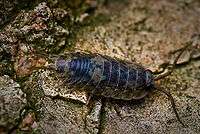
Living in a terrestrial environment, woodlice breathe through trachea-like lungs in their paddle-shaped hind legs (pleopods), called pleopodal lungs. Woodlice need moisture because they rapidly lose water by excretion and through their cuticle, and so are usually found in damp, dark places, such as under rocks and logs, although one species, the desert dwelling Hemilepistus reaumuri, inhabits "the driest habitat conquered by any species of crustacean".[33] They are usually nocturnal and are detritivores, feeding mostly on dead plant matter.
A few woodlice have returned to water. Evolutionary ancient species are amphibious, such as the marine-intertidal sea slater (Ligia oceanica), which belongs to family Ligiidae. Other examples include some Haloniscus species from Australia (family Scyphacidae), and in the northern hemisphere several species of Trichoniscidae and Thailandoniscus annae (family Styloniscidae). Species for which aquatic life is assumed include Typhlotricholigoides aquaticus (Mexico) and Cantabroniscus primitivus (Spain).[34]
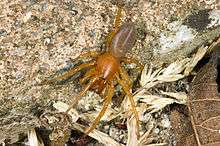
Woodlice are eaten by a wide range of insectivores, including spiders of the genus Dysdera, such as the woodlouse spider Dysdera crocata,[26] and land planarians of the genus Luteostriata, such as Luteostriata abundans.[35]
As pests
Although woodlice, like earthworms, are generally considered beneficial in gardens for their role in controlling pests,[36] producing compost and overturning the soil, they have also been known to feed on cultivated plants, such as ripening strawberries and tender seedlings.[37]
Woodlice can also invade homes en masse in search of moisture and their presence can indicate dampness problems.[38] They are not generally regarded as a serious household pest as they do not spread disease and do not damage sound wood or structures.
British Isles
There are over 45 native or naturalised species of woodlouse in the British Isles, ranging in colour and in size (3–30 millimetres or 0.1–1.2 inches). Of these 45 species, only five are common: Oniscus asellus (the common shiny woodlouse), Porcellio scaber (the common rough woodlouse), Philoscia muscorum (the common striped woodlouse), Trichoniscus pusillus (the common pygmy woodlouse), and Armadillidium vulgare (the common pill bug).
Classification
- Infraorder/Section Diplocheta
- Ligiidae
- Infraorder Holoverticata
- Section: Tylida
- Tylidae
- Section: Microcheta
- Mesoniscidae
- Section: Synocheta
- Buddelundiellidae
- Schoebliidae
- Styloniscidae
- Titaniidae
- Trichoniscidae
- Tunanoniscidae
- Section: Crinocheta
- Agnaridae
- Alloniscidae
- Armadillidae
- Armadillidiidae
- Balloniscidae
- Bathytropidae
- Berytoniscidae
- Cylisticidae
- Delatorreiidae
- Detonidae
- Eubelidae
- Halophilosciidae
- Olibrinidae
- Oniscidae
- Philosciidae
- Platyarthridae
- Porcellionidae
- Pudeoniscidae
- Rhyscotidae
- Scleropactidae
- Scyphacidae
- Spelaeoniscidae
- Stenoniscidae
- Tendosphaeridae
- Trachelipodidae
References
- "WoRMS – World Register of Marine Species – Oniscidea". www.marinespecies.org.
- Schmidt, Christian (December 5, 2008). "Phylogeny of the Terrestrial Isopoda (Oniscidea): a Review" (PDF). Arthropod Systematics & Phylogeny. 66 (2): 191–226. eISSN 1864-8312 – via Naturmuseum Senckenberg.
- "woodlouse | Origin and meaning of woodlouse by Online Etymology Dictionary". www.etymonline.com. Retrieved April 14, 2020.
- Broly, Pierre; Deville, Pascal; Maillet, Sébastien (December 23, 2012). "The origin of terrestrial isopods (Crustacea: Isopoda: Oniscidea)". Evolutionary Ecology. 27 (3): 461–476. doi:10.1007/s10682-012-9625-8. ISSN 0269-7653.
- Helmut Schmalfuss (2003). "World catalog of terrestrial isopods (Isopoda: Oniscidea) — revised and updated version" (PDF). Stuttgarter Beiträge zur Naturkunde, Serie A. 654: 341 pp.
- Sfendourakis, Spyros; Taiti, Stefano (July 30, 2015). "Patterns of taxonomic diversity among terrestrial isopods". ZooKeys (515): 13–25. doi:10.3897/zookeys.515.9332. ISSN 1313-2970. PMC 4525032.
- Dale Mayer (2010). The Complete Guide to Companion Planting: Everything You Need to Know to Make Your Garden Successful. Atlantic Publishing Company. p. 88. ISBN 9781601383457.
- "Dictionary of Newfoundland English – boat n". Retrieved February 27, 2012.
- "Bugs Bugs Bugs!" (PDF). Museum Victoria. Retrieved March 30, 2010.
- "Australian Word Map". Macquarie Dictionary. Macmillan Publishers, Australia. 2014. Retrieved February 8, 2015.
- "Dictionary of Newfoundland English – carpenter n". Dictionary of Newfoundland English. Retrieved September 29, 2016.
- Paul Kerswill. "The sound of Reddin". BBC. Retrieved September 17, 2006.
- James Chapple (January 14, 2016). "Everyone in Guildford is calling wood lice 'cheesy bobs' and it's brilliant". Trinity Mirror Group. Retrieved January 15, 2016.
- Howe, Ian (2012). Kent Dialect. Bradwell Books. pp. 7, 18. ISBN 9781902674346.
- "BBC Devon: Voices". BBC Devon. Retrieved June 25, 2012.
- "365 Urban Species. #093: Woodlouse". The Urban Pantheist. April 3, 2006. Retrieved January 18, 2009.
- Barber, A. D. (2015). "Vernacular names of woodlice with particular reference to Devonshire" (PDF). Bulletin of the British Myriapod & Isopod Group. 28: 54–63.
- "Sow bug". Dictionary.com Unabridged (v 1.0.1). 2006. Retrieved August 17, 2006.
- Matthew Francis (2004). Where the People Are: Language and Community in the Poetry of W.S. Graham. Salt Publishing. ISBN 978-1-876857-23-3.
- "Pillbugs". Niles Biological, Inc. Retrieved June 8, 2016.
- Oxford English Dictionary 1933: headword "Hog-louse"
- Aschehoug & Gyldendals store norske leksikon. 2 : Bag-Bru
- Bill Amos (August 10, 2002). "Little armored tanks". Caledonian-Record.
- Bert Vaux & Scott A. Golder. "Dialect Survey". Harvard University. Archived from the original on September 3, 2006. Retrieved September 30, 2006.
- Gail Smith-Arrants (March 20, 2004). "You say potato bug, I say roly-poly, you say…" (PDF). Charlotte Observer.
- Bruce Marlin. "Common Woodlouse, Sow Bug, Pillbug". North American Insects and Spiders. Retrieved February 10, 2009.
- Mairi Robinson, ed. (1987). The Concise Scots Dictionary (3rd ed.). Aberdeen: Aberdeen University Press. p. 628. ISBN 978-0-08-028492-7.
- Maria Minor & A. W. Robertson (2006). "Guide to New Zealand soil invertebrates: Isopoda". Massey University. Retrieved May 13, 2007.
- Josh Byrne (2009). "Fact Sheet: Slater Control". Retrieved May 22, 2012.
- "Wood Bug". Vancouver Sun. November 26, 2007.
- "How Now, Sow Bug?," Discover, August 1999, 68. Available from: https://msvictorialin.wikispaces.com/file/view/sow-bug-article.pdf
- "Pill woodlouse (Armadillidium vulgare)". ARKive.org. Archived from the original on September 3, 2009. Retrieved February 13, 2009.
- Rod Preston-Mafham & Ken Preston-Mafham (1993). "Crustacea. Woodlice, crabs". The Encyclopedia of Land Invertebrate Behavior. MIT Press. p. 161. ISBN 978-0-262-16137-4.
- Ivo Karaman (2003). "Macedonethes stankoi n. sp., a rhithral oniscidean isopod (Isopoda: Oniscidea: Trichoniscidae) from Macedonia" (PDF). Organisms Diversity & Evolution. 3 (8): 1–15. doi:10.1078/1439-6092-00054.
- Prasniski, M. E. T.; Leal-Zanchet, A. M. (2009). "Predatory behavior of the land flatworm Notogynaphallia abundans (Platyhelminthes: Tricladida)". Zoologia (Curitiba). 26 (4): 606. doi:10.1590/S1984-46702009005000011.
- Bailey, Pat (March 15, 1999). "Humble Roly-Poly Bug Thwarts Stink Bugs in Farms, Gardens". UC Davis News Service.
- Phillip E. Sloderbeck (2004). "Pillbugs and sowbugs" (PDF). Kansas State University.
- "Sow Bugs". Pestcontrolcanada.com. Retrieved August 17, 2012.
External links
Further reading
- Helmut Schmalfuss (2003). "World catalog of terrestrial isopods (Isopoda: Oniscidea) — revised and updated version" (PDF). Stuttgarter Beiträge zur Naturkunde, Serie A. 654: 341 pp. (lists all validated species of Oniscidea published up to the end of 2004)
- Helmut Schmalfuss; Karin Wolf-Schwenninger (2002). "A bibliography of terrestrial isopods (Crustacea, Isopoda, Oniscidea) — revised and updated version" (PDF). Stuttgarter Beiträge zur Naturkunde, Serie A. 639: 120 pp. (lists most scientific publications on the biology of Oniscidea published in a European language until the year 2004.)
- Christian Schmidt & Andreas Leistikow (2004). "Catalogue of the terrestrial Isopoda (Crustacea: Isopoda: Oniscidea)" (PDF). Steenstrupia. 28 (1): 1–118. (lists all genera published up to the end of 2001)